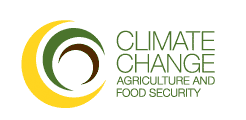The CGIAR Research Program on Climate Change, Agriculture and Food Security (CCAFS) has pubished a booklet on six steps needed to achieve climate resilience in agriculture while also reducing agricultural emissions.
Using examples from five years of CCAFS research, the booklet lays out how actions on disseminating technology, promoting insurance, delivering climate forecasts, enhancing national enabling environments, informing global policies and processes, and scaling up investments in climate smart agriculture contribute to making the world's poorest farmers more climate resilient.
 November 2015: The CGIAR Research Program on Climate Change, Agriculture and Food Security (CCAFS) has pubished a booklet on six steps needed to achieve climate resilience in agriculture while also reducing agricultural emissions. Using examples from five years of CCAFS research, the booklet lays out how actions on disseminating technology, promoting insurance, delivering climate forecasts, enhancing national enabling environments, informing global policies and processes, and scaling up investments in climate smart-agriculture contribute to making the world’s poorest farmers more climate resilient.
November 2015: The CGIAR Research Program on Climate Change, Agriculture and Food Security (CCAFS) has pubished a booklet on six steps needed to achieve climate resilience in agriculture while also reducing agricultural emissions. Using examples from five years of CCAFS research, the booklet lays out how actions on disseminating technology, promoting insurance, delivering climate forecasts, enhancing national enabling environments, informing global policies and processes, and scaling up investments in climate smart-agriculture contribute to making the world’s poorest farmers more climate resilient.
For each step, the booklet provides short examples and success stories from projects implemented by CCAFS and it partners with links to further information.
Step 1 (putting the right technology into farmers’ hands) is illustrated with experiences from laser land leveling, which can boost yields while reducing emissions and water use, and from climate-smart feed production and feeding techniques in dairy production.
Step 2 (get farmers insured) is explained with examples from weather index insurance in India, and index-based livestock insurance.
Step 3 (deliver climate forecasts directly to farmers) is illustrated with advances in using big data-based climate forecasts in Colombia and developing climate information systems for African farmers.
Step 4 (enhance the national enabling environment) is supported by a list of examples of successful national and regional policies in poor countries around the world.
Step 5 (inform global policies and processes) shows how CCAFS research is influencing global assessments, such as the Intergovernmental Panel on Climate Change (IPCC), as well as regional assessments and policy making processes.
Finally, Step 6 (scale up investments in climate-smart agriculture) is exemplified with recent investments in adaptive capacity development in coffee and cocoa production in Nicaragua and investments by the World Food Programme (WFP) in agricultural extension across Africa.
CCAFS is a collaborative project among the international agricultural research centers and research programs of the CGIAR Consortium. [Publication: Six Steps to Success: How to Make 500 Million Farmers Climate-Resilient in 10 Years While also Reducing their Agricultural Emissions]